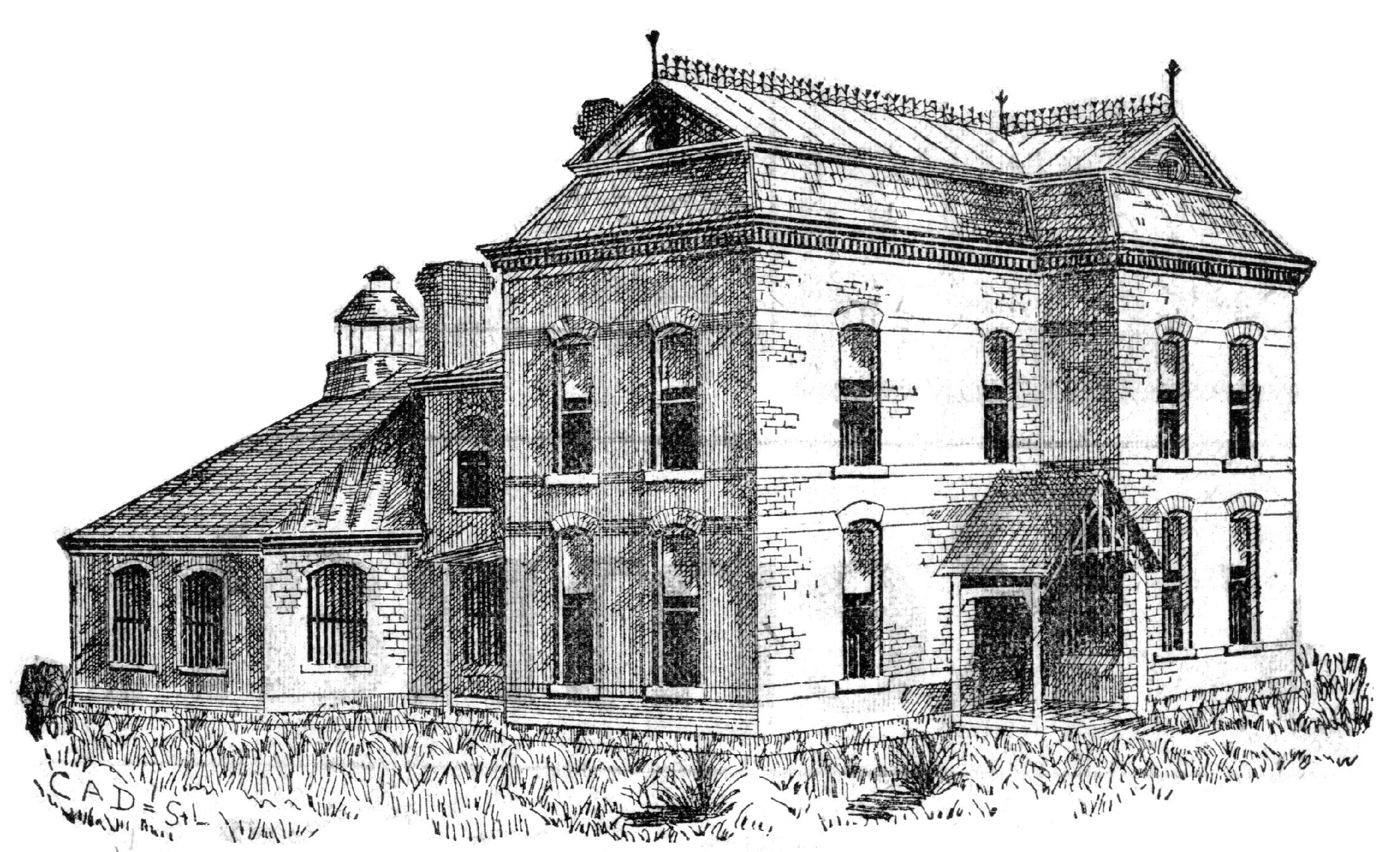Scenes, people and businesses that once defined Jameson, MO:
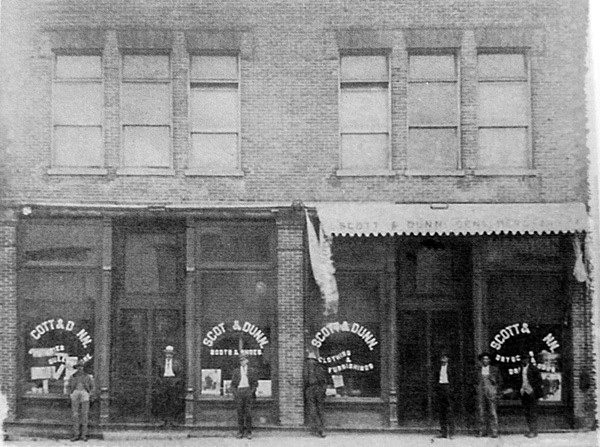
Scott & Dunn was a dry goods store in Jameson, located on the west side of Main Street between Second and Third streets. It opened in 1932. The 2-story brick building carried a variety of goods including fabric, notions, ready-made clothing, hats, glassware, groceries, and shoes, featuring those made by the Brown Shoe Company. The store bought produce and poultry locally.

The Jameson House was located at First and Chestnut Streets, diagonally across from the Wabash Depot, in Jameson, MO. The two-story hotel was managed by Mrs. Eliza Ann (Brown) Hubbard. The 1937 Daviess County souvenir centennial edition of the Gallatin Democrat reported that the hotel “contains 20 elegantly furnished good-sized rooms, and is surrounded by extensive grassy lawns shaded by maple trees …Rates are $1.50 per day.”

When Carl and Hortense (Feurt) Alexander established the original Alexander’s Market in 1943, it was located in the building north of Duly’s Garage on the east side of Jameson’s Main Street. They purchased this property from Ivan Caraway. Two years later, they purchased J.C. Tingler’s grocery, located south of Duly’s Garage. This building interior is pictured above. The south wall of the market was constructed from bricks left after a fire destroyed a row of businesses in the 1930’s. It was there they operated their store until 1968, when son Dale and his wife, Frances Ann (Richards) Alexander took over. In its heyday, the store bought eggs locally and shipped out more than 300 dozen a week. Dale and Frances operated the business until 1981, when it was closed and auctioned.

The Jameson Opera House was located on the east side of Main Street. The Opera House occupied the second floor of the building which had businesses on the first floor – at one time the Farmers Bank on the north, Merrifield’s Café in the middle and a millenary shop on the south. After a fire destroyed the building, its bricks were used to help build Duly’s Garage and Alexander’s Market. By 2017, only the north side of Duly’s and the south side of Alexander’s Market are all that remain of the original opera house structure.

The Jameson Drug Company was located on the west side of Main Street between Second and Third streets. Among the town’s drug store owners over the years were Matt Cavolt, Marion Barnes, Hugh Wells, Tom Magee, and George and Henry French.

Dr. James B. Graham was born in Gentryville, MO on Oct. 18, 1873, a son of Dr. George and Martha Jane Graham. He received his education in the public schools of Trenton, MO, McFall High School and Avalon College. Upon receiving his license following his graduation from Barnes Medical School in St. Louis, he began his career in Jameson and continued his practice until his illness and death. He married Maud C. Miller. They had five children: Junior; Lois; Jack; Mary Elizabeth and Nancy. He had an exceptional talent for diagnosing ailments. He was on call 24 hours a day, going by horseback, horse and buggy and finally by car when the country roads would permit. He was truly a dedicated physician, and was sadly missed at his passing by many.

This postcard scene dated 1908 was taken of hunters camped near the Grand River Bridge at Jameson, MO. (courtesy Ellis Antiques, Jamesport)

John R. Somerville began his lumberyard on the corner of Second and Main Street in Jameson, MO., after the Stormfeltz Lumber Company, where he was manager, was destroyed by fire during the Depression. Later he and wife Edna expanded the store to include hardware and paint. Gift items, featuring fine glassware, were also available. Many remember the annual Christmas open house, when refreshments were provided. The Masonic and Order of the Eastern Star Lodge Hall was above the store. The store was destroyed by fire in December of 1970.

Members of the Jameson Christian Church (date unknown, courtesy Jimmy Barton)

Three long-time Jameson Post Office workers, shown in the early 1960’s, are John Smith, Jesse Ferguson, and Jack Tingler. After serving briefly as the Jameson postmaster, John carried mail on a rural route in Jameson for 30 years. Jesse was postmaster from 1959 to 1977. Jesse received official notice of his appointment to the job via telegram delivered by Ava Pugh, the Jameson railroad station agent. Jack carried mail from Jameson between 1959-1965, when he transferred to rural routes in Altamont and Winston, where he worked until retirement in 1983.

Jameson native John Smith worked at the Caraway Grocery in Jameson from 1938 to 1941. Then John and his wife, Marjorie (Franks), started the Smith Grocery Store on the south side of Second Street and east of the rock café in Jameson. They operated it for nine years, from approximately 1946 to 1955. In 1956, they sold the store to Harold Adams when John was appointed postmaster of the Jameson Post Office. Later the Maharg Grocery operated in the same building.

Jameson’s “hard rock café” near the southeast corner of Main Street and Highway OO was built in the late 1930’s by Bob Steele for Judge and Hazel (Smedley) Gaines to open a gas station and café. Ava Pugh owned the building for a time and sold it in the late 1940’s to John (J.C.) and Mildred Roberts, who operated Roberts Café and Standard Oil Gas Station there. A bit later the couple pictured here, Cliff and Elzada Roberts, parents of J.C, took over running the café and station, which they operated until the 1960’s. Some of the others who operated a café in this building were Donna King, Dorothy VanBelkum, Tom McHarque, Mary Beeman, Donnie & Georgia Moulin, and Alan & Mae Hoyle.
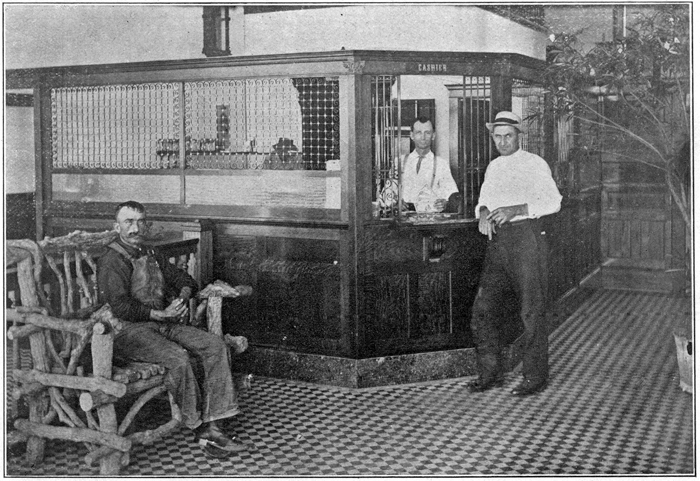
This is the teller’s window of the Bank of Jameson, MO. (date unknown)

Abe and Walter Merrifield’s Barber Shop was located in a two-story brick building on the east side of Main Street between Second and Third Streets in Jameson, MO. The building was later used for many years as the Jameson Post Office. In July 2017, it houses the town museum. Other barbers in Jameson over the years have included John Curtis, Tom Simmons, Ed Davis, George Flint, Red Douglas, and Harry Wheeler, Jr.
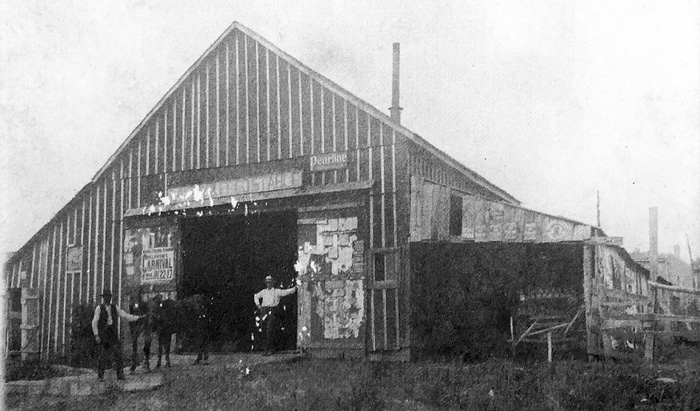
The Blacksmith shop was located on the west side of Main Street, just north of the railroad tracks. It sold feed and provided livery service for the town. Among the town’s blacksmiths over the years were: John Copeland, George Srucker, Frank Gillespie, John Marshman, John and Ivan Wilder, Frank Bland, and Tom Cannon.

This card featuring a street scene in Jameson, MO, declares “this town’s a hummer!” (date unknown)
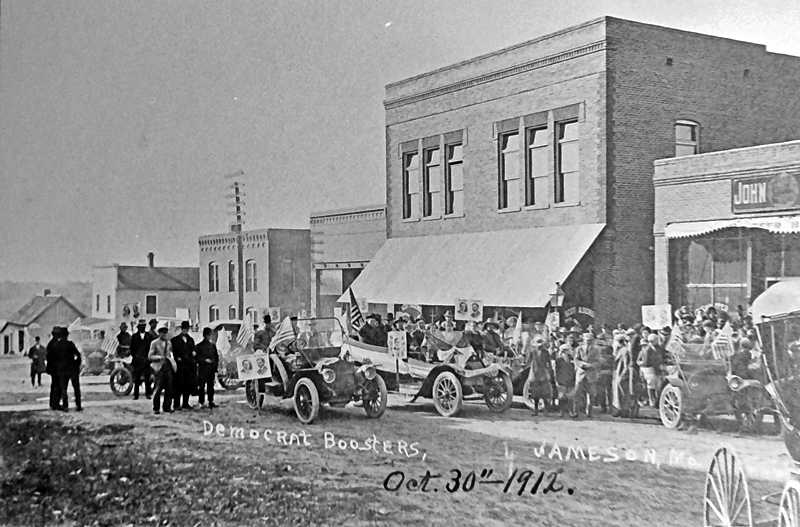
Democratic Boosters at Jameson, MO, rallied on Oct. 30, 1912. Notice the Coleman street lamp later requested by the Coleman Company since so few were still existent and their records showed Jameson as the buyer. This scene shows the west side of Jameson’s Main Street. Buildings, right to left, were Schaffer Hardware, the Scott & Sons General Store (2nd story housing the Masonic Lodge), French Drug Store, and a building of John F. Brown Lumber which later housed Somerville Lumber. The top part of this building was the central telephone office for the community. Use of the next building is known; the Co-op building is next. Practically all buildings were destroyed by fire. (original Liddell Studio photo, courtesy Jack Tingler)

The Caraway Grocery Store was located west of the Christian Church on the north side of Second Street (now Highway OO) In Jameson, MO. It was owned by Ivan Caraway and his wife, Linneus. John Smith (pictured in the middle) worked in the store before his service in WWII. Ivan is pictured at right (the person at left is unidentified). When this building burned, groceries were delivered to and sold from Somerville’s Hardware until the Caraways purchased and re-opened their business in the former newspaper building (the Jameson Gem), located on Main Street, north of what is now Duly’s Garage.

This bridge once spanned the Grand River near Jameson, MO (date unknown)

A pre-Civil War gristmill, operated by John & William Lewis, was located 3 miles west of Jameson on the Grand River. Farmers brought grain to be ground and merchants came to buy grain, flour and meal for their stores. Remains of the mill were discovered in 1989 when the nearby Lewis Mill bridge (shown here by artist drawing) was being replaced.
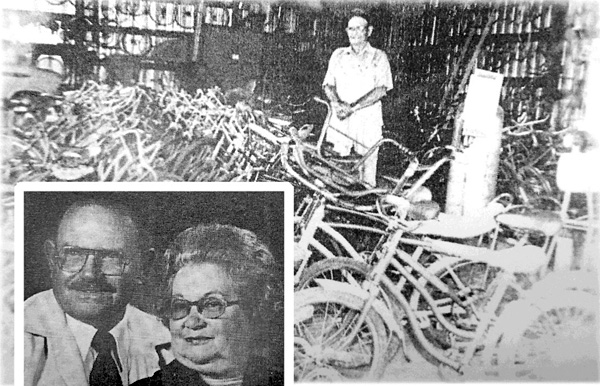
Rufus Hefley started repairing bicycles when he was 12 years-old after older boys riding horses stopped him, took his bicycle, and tore it up. He saved his money, ordered parts and repaired it himself. He turned that experience in 1922 into a vocation of repairing and rebuilding bicycles for the rest of his life. Rufus and his wife, Cleo, were married Feb. 22, 1930, and began farming in the Pattonsburg and McFall area. In 1942 they purchased a farm three and one-half miles west of Jameson where they lived and farmed until June 1974. They sold this farm and built a new house in Jameson where they retired. They have two children: Max and Nancy (Hefley) Terry. Rufus and Cleo enjoyed their retirement and family and spent a portion of their retirement years in southern Texas. When Rufus and Cleo moved to Jameson from the farm, they built a new home on the west edge of town. Rufus built and used a 40’x60’ building to house the bicycles, parts and repair shop. People traveled from a 40-mile radius to purchase used bicycles from Rufus or to get their bicycle repaired. Many Jameson youth were thrilled to choose and own a bicycle from Rufus.

The building known as Duly’s Garage since 1946 has been one of the main gathering places for Jameson folks since the existence of Jameson as a town. Originally on this site on the east side of Main street was a brick building, three lots wide and two stories tall; the Jameson Opera House was located on the second story. Later, the Farmers Bank of Jameson occupied the lower level of the northern-most lot of the original building. In 1936 the entire block of buildings was destroyed by fire. From partially standing walls, two single-story brick buildings were constructed. The southern-most lot is the location of Alexanders’ Market. On the northern-most lot was built an automotive garage. Several owners and others operated automotive businesses in the building, but Robert F. and Eleanor A. Duly owned it for the longest period of time and are the most well known operators.

Bob (Robert Harold) Drummond and his family moved to Jameson in June, 1945, after his discharge from the U.S. Army’s Sixth Armor Field Artillery Division during World War II. In 1950 he built and operated a welding and mechanic garage with his wife LaVerne, who was the parts person for the business. In 1957, Bob hired Ralph Hughes and Ralph Shaw to work in the garage. Bob later sold the business to Leroy Miller. The building in 2017 is now housing Jameson City Hall.

Lawrence and Linda (Pugh) Holley were educators who loved their relationships with the students, staff and community of Jameson. They believed in the small school because of the opportunity it gave each child to participate in every school activity. They were born, raised and graduated from high school in Coffey, MO. They married in 1937 and had one son, Larry (also and educator). Both taught in one room country schools and received their undergraduate degrees from the University of Central Missouri. Mr. Holley earned his Master’s Degree from the University of Missouri-Columbia. He taught 7th and 8th grade at Jameson before becoming Superintendent. After a tour of duty in the Navy (WWII), the Holley’s returned to Jameson, their home, the rest of their lives. Along with administrative duties, Mr. Holley taught, coached, directed class plays and initiated the annual senior trip (1949). Mrs. Holley taught, was the school librarian, directed the ‘hot lunch’ program, directed plays, kept score at basketball games and served as Principal. Mr. Holley was involved in the Lions Club, Baptist Church and Masonic Lodge; Mrs. Holley in the Christian Church, Rebekah Lodge, Eastern Star and DAR. Mr. Holley built the Jameson school into one of the finest small educational institutions in the State. He took great pride in sportsmanship, patriotism and good manners. Mrs. Holley is remembered for her enthusiasm and positive support of her students. They were a couple who served the Jameson community with pride and love!
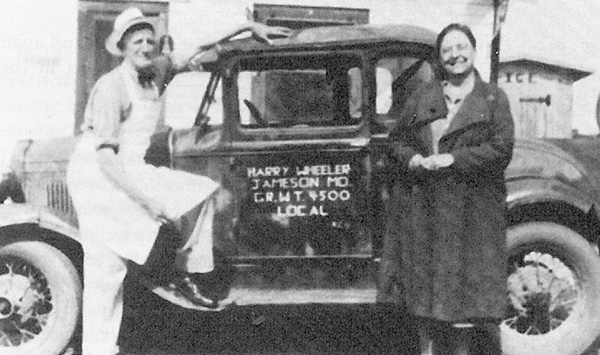
Harry J. Wheeler, Sr., and his wife, Frankie, owned and operated Wheeler Cafe located on the southwest corner of Route OO and Main Street in Jameson, MO. It was the gathering place for the young people of the community in the early 40’s. Couples could put a nickel in the juke box and dance to such songs as “One Dozen Roses” or “I’ve Got Spurs That Jingle, Jangle, Jingle.” Coca-Cola in glass bottles was sold for five cents. The café opened in the 1930’s and remained open until 1959. The building came down in the 1960’s.

Harry James Wheeler Jr. and Mary Belle Trapp were married, Jan. 2, 1946. They built and lived in a house one block east of the park in Jameson. They raised five children: Vicki, Harry III, Leta, Beth, and Frank. Harry was born near Jameson in 1917 and died in 1974. He pitched baseball, played basketball, pitched horseshoes, and refereed. The lighted baseball field in Jameson was dedicated in his honor in 1981. Harry barbered, farmed, milked cows, and sold real estate, but he was primarily an auctioneer. Wheeler’s Auction Service was a family business with Mary regularly acting as collector and one of their children serving as clerk. Mary was born in 1918 near Waldo, KS and died in 1986. After graduating from Waldo High School, she earned a Bachelor’s degree in nursing from Kansas State. A full-time homemaker who raised chickens, sewed, and gardened, Mary was also the one Jameson residents called when they had a medical concern. Mary started the Daviess County Health Department, retiring in 1980. Both Harry and Mary were active in the Jameson Baptist Church, the Order of the Eastern Star, the local school board, and numerous community activities.
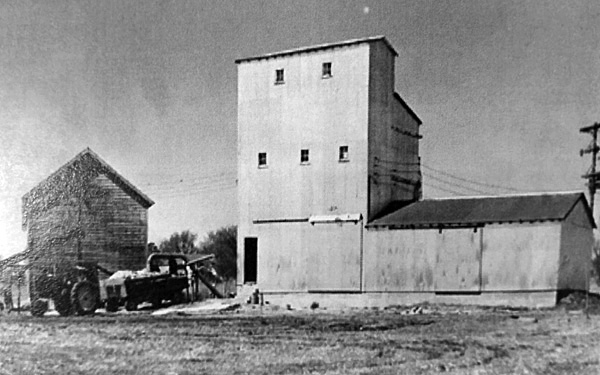
Eben Estes and his sons, J.D. and Glen, built and operated this popcorn processing plant located on the northwest corner of the intersection of Highway 13 and State Route OO in Jameson, MO. The plant bought corn from area farmers, shelled, cleaned and bagged it before shipping it throughout the United States by carloads on the railroad. The plant hired several workers. In November, 1954, just over a year after the plant opened, it was destroyed by a fire.

This band stand was first located on the west side of Main Street near Second Street in Jameson, MO. It was then moved to the park. Later it was moved back to Main Street in the center of the block on the east side, then back to the park. Again it was moved to Main Street on the south side of Second Street. It was used for band concerts and as a stage at the Jameson Picnic. In later years, it served as Jameson’s “forum” where most world problems could be resolved along with some plain and fancy whittling. It was destroyed by vandals on a Halloween night in the mid 40’s.
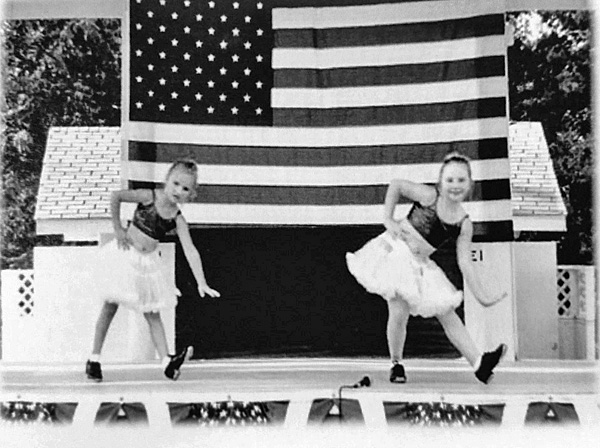
The annual amateur local talent show/contest is a decades-long tradition of the Jameson Picnic. Each year people of all ages sing, dance, and play musical instruments to the delight of the crowd.

This poster promoted the Centennial (1991) year of the Jameson Picnic. In 1892, the Knights of Pythias instituted an annual celebration to be known as the Jameson K.P. Picnic to be held on August 9. It was started as a daytime picnic for K.P. Lodge members and friends. People came by wagon, buggy, and horseback. In later years, the railroad would run special passenger trains from the east and the west, bringing people to the Picnic. When it was extended to a 3-day event, the date was changed to the last three days of the week nearest August 9. After the K.P’s surrendered their charter, local merchants carried on until the Lions Club was organized in October, 1952. Jameson Lions Club has sponsored the event ever since.
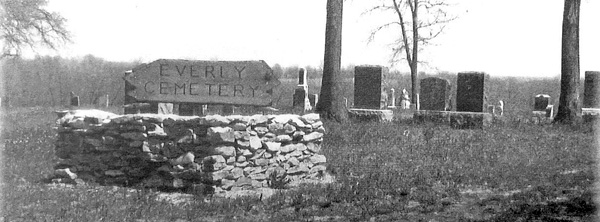
Everly Cemetery, located one mile southeast of Jameson, has the oldest dated gravestone in Grand River Township. The gravestone is dated 1835, marking the resting place of an infant son of J. N. and Nancy Netherton. As recorded in a 1970 survey, the cemetery has the graves of 170 people, including 49 children under eight years of age. Sixty-two different family names are represented. Four of the deceased are listed as Civil War soldiers. LDS missionaries residing at Adam-ondi-Ahman restored the gravesites and continue to maintain the grounds.

A large commercial building was operated by Moorman’s Feed as a feed grain terminal along the railroad tracks, near the entrance to Adam-ondi-Ahman off Highway 13 at Jameson, MO. The grain terminal, constructed with the assistance of the Gallatin Industrial Development Corporation, was short lived in operation. (circa 1980s)

Among the last active storefronts open for daily business in Jameson, MO, was the U.S. Post Office. Grand River Museum was housed for a time in the building next door along Main Street. (date unknown)

Jameson is the only incorporated town in Grand River Township of Daviess County, MO. Never a large town in population or area, it was none-the-less a very active business center after the St. Louis, Chillicothe & Omaha Railroad was completed in 1871. The locate of the first store in Jameson was at the corner of 2nd and Main Streets, a vacant lot when this photo was taken in 1979.

By July, 2017, one of the oldest remaining houses in Jameson was the Hefley residence built in 1884. In 1958, Max and Lavene Hefley purchased the house from the Bert Barnett family. The Hefley’s added water and plumbing to the house and have cared for it well over the past 55 years. It is located directly west of the City Park on Main Street. Visitors to Jameson and the Jameson Picnic always comment on the beauty of the house and its colorful landscaping.
Max and Lavene raised their children, Denise and Vance, in this home. Lavene died in 2009; Max continues to live in and care for their home.

This 1½-story house (2338 square feet), located one-half mile south of Jameson (on Koala Road), was built in 1900. The architectural style is called “Airplane Bungalow” as the partial second floor resembles a cockpit over wings. The walnut wood for the interior trim and the field stone supporting the porch’s roof were both harvested from the property. The Charles Prichard family built the home and owned it until 1927. It was then purchased by David E. Cope and remained with his family until 1939 when it was purchased by Edward and Alma Lankford. In 1959 Elmer and Roberta Gordon purchased the house and property. In 1966 the Gordon’s sold the house and property to the Andrews & Madget Farm Company, who later sold the property to the Church of Jesus Christ of Latter-day Saints (LDS) in 1975. The houses LDS church missionaries who rotate their stay and service at Adam-ondi-Ahman during their 18 month-long missions. Today (2017), 117 years after its construction, this house remains a significant landmark in the Jameson community.

Aladdin Homes premiered kit houses in 1906 in Bay City, MI. In 1908 Sears Roebuck & Company became the largest provider. Buyers enjoyed the convenience and affordability of a pre-fabricated dwelling. The purchasers would receive all necessary supplies in shipment exclusively by rail. These would typically fit into two box cars for assembly by the new homeowner or a local contractor. Every piece of framing lumber was numbered at the factory for assembly at the construction site. In 1910, the Adam-ondi-Ahman White House arrived on Wabash Rail costing $780. The purchaser Mr. Smith related, “Assembling compared with playing Tinker Toys.” Some 100,000 kit houses were built in the U.S. between 1908 and 1940. Though the market for these houses declined following the stock market crash of 1929, people looking for affordable housing again discovered kit houses in the 1980’s. As of July, 2017, the house is still a functional dwelling on Koala Road southeast of Jameson.
A Streetcar Hoax:
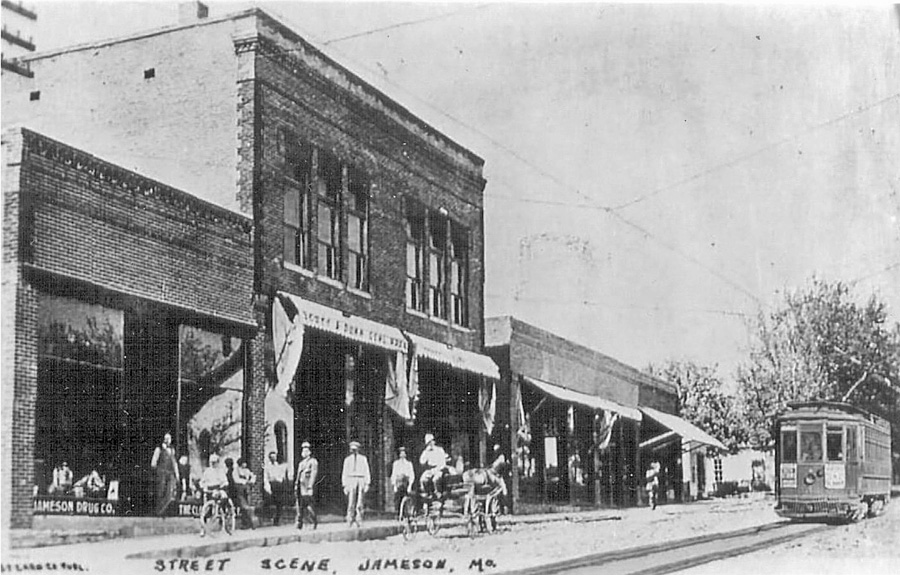
In the early 20th Century, up-and-coming communities had streetcars or trolleys. Jameson had one, too… at least according to a (bogus) postcard scene. An entrepreneur, looking to make a buck, toured small towns with a fake street car (that unfolded up to carry) and included wires to make it look more authentic. This picture is a reproduction of Jameson’s street car postcard set against the Scott and Dunn general store on the west side of Main Street.

